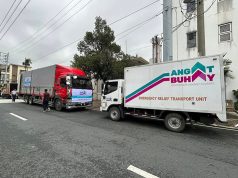A Twitter user shared a screenshot of his reply to a spam text message that purportedly came from the “Office of Wowowin” with the “sponsorship” of television host Willie Revillame.
User @ariesleguin_el replied to the text message that came from an 11-digit number claiming he has won P650,000,000 and cited that it was the program’s supposed “fourth anniversary.”
ONANAY STOP pic.twitter.com/4lpMWWVmDC
— Kal (@ariesleguin_el) May 19, 2019
However, it is to be noted that there is no such thing as the “Office of Wowowin.” There are no reports of the program celebrating its fourth anniversary as well.
Further, the alleged “DTI #” contains the “SY” which generally pertains to “school year” even though the text message does not have anything to do with school or the academic sector.
There is also a question mark at the end of “ASAP” even if the sentence was a declarative type.
The Twitter user replied to the suspicious text message by joking that the scammer has “subscribed” to “Daily Onanay Facts” and that P25 would be deducted from his cellular load regularly.
The joke prompted the scammer to request for a “stop” in his so-called subscription.
“STOP. ONANAY STOP,” the scammer said in the text message.
The whole exchange expectedly amused Twitter users.
The original poster, meanwhile, figured that the scammer might have panicked at the thought of having P25 be deducted from his cellular load, hence the reaction.
People can report spam or scam messages to the National Telecommunications Commission (NTC) through its website.
How scammers get numbers
There are different ways on how scammers can get the mobile number of an individual, according to Ramon Nolasco Jr, the former officer-in-charge of the NTC consumer welfare and protection division.
He said that some scammers can get mobile numbers in written surveys or customer feedback forms of restaurants.
“May mga fini-fill-up na forms na kahit survey lang, may provision doon for a mobile number. Minsan, kahit nga ‘pag kumain ka sa mga restaurants, ‘di ba? Puwedeng pagmulan nun or pagkunan ng number na gagamitin sa scam,” Nolasco said in an interview.
However, the scammer is not necessarily the one who has given out the form.
The former OIC shared that people can buy the information from the ones giving out the form.
There is also the possibility that scammers use different types of equipment to gather mobile numbers. One of them is the SMS (short messaging system) broadcast equipment.
“Ginamit nila ‘tong equipment na ‘to, edi puwede kang mag-send without buying numbers, ‘di ba? Without even buying information, without even obtaining it from someone else,” Nolasco said.
“Ang bilis lang. Gagamitin mo ‘yung equipment na ‘yon para makapag-send ng text scam message mo,” he added.
The National Disaster Risk Reduction and Management Council is only agency authorized to use such an equipment in sending text messages for disasters and natural calamities.










